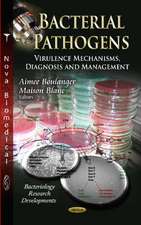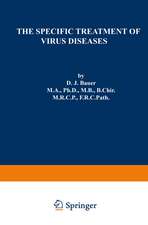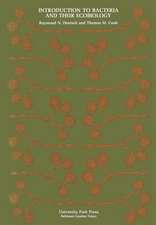Recognition of M. leprae antigens: Developments in Hematology and Immunology, cartea 17
Autor Tom Ottenhoff, René de Vriesen Limba Engleză Paperback – 28 ian 2012
Din seria Developments in Hematology and Immunology
- 5%
 Preț: 715.19 lei
Preț: 715.19 lei - 5%
 Preț: 1098.84 lei
Preț: 1098.84 lei - 5%
 Preț: 1414.64 lei
Preț: 1414.64 lei - 5%
 Preț: 358.84 lei
Preț: 358.84 lei - 5%
 Preț: 366.70 lei
Preț: 366.70 lei - 5%
 Preț: 2115.92 lei
Preț: 2115.92 lei - 5%
 Preț: 723.21 lei
Preț: 723.21 lei - 5%
 Preț: 388.48 lei
Preț: 388.48 lei - 5%
 Preț: 361.80 lei
Preț: 361.80 lei - 5%
 Preț: 1103.22 lei
Preț: 1103.22 lei - 5%
 Preț: 720.68 lei
Preț: 720.68 lei - 5%
 Preț: 362.37 lei
Preț: 362.37 lei - 5%
 Preț: 721.77 lei
Preț: 721.77 lei - 5%
 Preț: 1414.29 lei
Preț: 1414.29 lei - 5%
 Preț: 2117.93 lei
Preț: 2117.93 lei - 5%
 Preț: 1418.68 lei
Preț: 1418.68 lei - 5%
 Preț: 1102.46 lei
Preț: 1102.46 lei - 5%
 Preț: 722.33 lei
Preț: 722.33 lei - 5%
 Preț: 720.10 lei
Preț: 720.10 lei - 5%
 Preț: 724.14 lei
Preț: 724.14 lei - 18%
 Preț: 951.91 lei
Preț: 951.91 lei - 5%
 Preț: 1414.64 lei
Preț: 1414.64 lei - 5%
 Preț: 1100.64 lei
Preț: 1100.64 lei - 5%
 Preț: 1100.30 lei
Preț: 1100.30 lei - 5%
 Preț: 1090.94 lei
Preț: 1090.94 lei - 5%
 Preț: 1105.77 lei
Preț: 1105.77 lei - 15%
 Preț: 592.59 lei
Preț: 592.59 lei - 5%
 Preț: 1414.29 lei
Preț: 1414.29 lei - 5%
 Preț: 983.19 lei
Preț: 983.19 lei - 5%
 Preț: 1105.77 lei
Preț: 1105.77 lei
Preț: 361.23 lei
Preț vechi: 380.25 lei
-5% Nou
Puncte Express: 542
Preț estimativ în valută:
69.13€ • 75.06$ • 58.07£
69.13€ • 75.06$ • 58.07£
Carte tipărită la comandă
Livrare economică 23 aprilie-07 mai
Preluare comenzi: 021 569.72.76
Specificații
ISBN-13: 9789401079945
ISBN-10: 9401079943
Pagini: 160
Ilustrații: 156 p.
Dimensiuni: 155 x 235 x 8 mm
Greutate: 0.23 kg
Ediția:Softcover reprint of the original 1st ed. 1987
Editura: SPRINGER NETHERLANDS
Colecția Springer
Seria Developments in Hematology and Immunology
Locul publicării:Dordrecht, Netherlands
ISBN-10: 9401079943
Pagini: 160
Ilustrații: 156 p.
Dimensiuni: 155 x 235 x 8 mm
Greutate: 0.23 kg
Ediția:Softcover reprint of the original 1st ed. 1987
Editura: SPRINGER NETHERLANDS
Colecția Springer
Seria Developments in Hematology and Immunology
Locul publicării:Dordrecht, Netherlands
Public țintă
ResearchCuprins
1 Introduction.- 2 MHC Class II Ir/Is Gene Controlled Antigen Specific T Cell Activation and Disease Susceptibility: Leprosy, A Human Model.- 3 HLA Class-II-Restricted Mycobacterium Leprae-Reactive T-Cell Clones from Leprosy Patients Established With a Minimal Requirement for Autologous Mononuclear Cells.- 4 Mycobacterium Leprae Specific Protein Antigens Defined by Cloned Human Helper T Cells.- 5 Cloned Suppressor T Cells from a Lepromatous Leprosy Patient Suppress Mycobacterium Leprae Reactive Helper T Cells.- 6 Molecular Localization and Polymorphism of HLA Class II Restriction Determinants Defined by Mycobacterium Leprae Reactive Helper T Cell Clones from Leprosy Patients.- 7 HLA-DR3 Molecules are the Products of an HLA Class II Immune Regulator Gene for Mycobacterium Leprae Predisposing to Tuberculoid Leprosy.- 8 Evidence for an HLA-DR4 Associated Immune Response Gene for Mycobacterium Tuberculosis: A Clue to the Pathogenesis of Rheumatoid Arthritis?.- 9 General Discussion: Mycobacterium Leprae Specific Activation of Helper and Suppressor T Cells and its Regulation by HLA Class II Genes and Products.- Short Summary.















